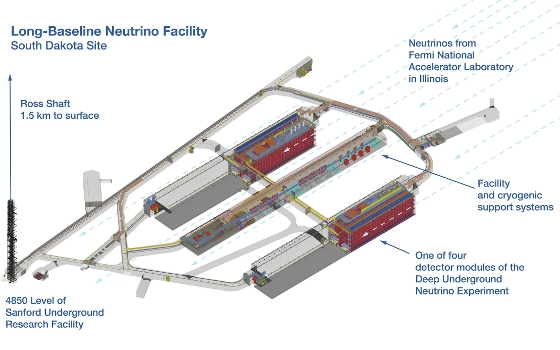 |
| December 01, 2020 | Volume 16 Issue 46 |
Designfax weekly eMagazine
Archives
Partners
Manufacturing Center
Product Spotlight
Modern Applications News
Metalworking Ideas For
Today's Job Shops
Tooling and Production
Strategies for large
metalworking plants
Deep Underground Neutrino Experiment: Contract awarded for excavation of gigantic caverns
Construction of an enormous underground facility in South Dakota for the largest international physics experiment in the United States took a major step forward recently. Project managers at the Department of Energy's Fermi National Accelerator Laboratory awarded Thyssen Mining a contract to excavate the gigantic caverns for Fermilab's Long-Baseline Neutrino Facility (LBNF). The caverns will be located a mile underground, rise up to seven stories tall, and cover an area almost the size of two football fields.
Excavation crews will drill, blast, and remove approximately 800,000 tons of rock to create the underground space for the LBNF. When complete, the facility will house the enormous particle detector for the international Deep Underground Neutrino Experiment (DUNE), hosted by Fermilab. More than 1,000 scientists from over 30 countries are collaborating on DUNE, which will provide the foundation for international neutrino research for decades to come.

The Long-Baseline Neutrino Facility will comprise three caverns to house and support the international Deep Underground Neutrino Experiment. The north and south caverns are identical in size (475 ft long x 65 ft wide x 92 ft high) and will house the gigantic DUNE particle detector modules. The central cavern (624 ft long x 64 ft wide x 37 ft high) will accommodate cryogenic equipment and other utilities needed for the experiment. [Image: Fermilab]
Excavation of the underground complex will take place at the Sanford Underground Research Facility in Lead, SD, in space leased to the Department of Energy for this project.
The excavation will create underground space that will house the experiment as well as laboratory space, a maintenance shop, generator room, spray chamber, and a series of interconnecting tunnels, called drifts, to connect the three large caverns in which the DUNE neutrino detector modules and utilities will be installed. The total footprint of the underground facility exceeds four acres (more than 16,000 m2).
Thyssen Mining has begun the early mobilization period of the contract. This period includes the onboarding of personnel, contracting local vendors, and preparing equipment for use underground. On-site construction work will begin in April 2021.
"Our planned labor force for this project is expected to be between 110 and 120 people," said U.S. General Manager Ryan Moe, Thyssen Mining. "Our team will consist of many of our trained and experienced miners, operators, mechanics, electricians, engineers, and managers who have worked on multiple cavern projects within the Thyssen organization. We will, in the near term, however, be posting numerous positions locally to fill in alongside with many of these similar roles. As our planning advances, we'll have better information on the exact number of positions needed."
The excavated rock will be hoisted up a vertical shaft from one mile underground and then transferred 4,200 ft on a system of conveyor belts that was built this year by Kiewit Alberici Joint Venture, the construction manager and general contractor for the LBNF project. When operational, the new rock transportation system will move the rock from the hoist to a former open-cut mining pit in Lead.
The conveyor itself should not create any noticeable noise; however, rock falling from the conveyor into the open cut may generate audible noise, within the limits permitted by city ordinance. A letter to local residents provides more information.
When the caverns are complete, the LBNF and DUNE teams will install the infrastructure and equipment needed for neutrino research. Using the particle accelerator complex at Fermilab, scientists will send an intense neutrino beam through 808 miles (1,300 km) of rock from Illinois to the DUNE particle detector in South Dakota to understand the role that neutrinos -- the most abundant matter particles in the universe -- play in our cosmos.
The short animation below shows a virtual walk through the South Dakota portion of Fermilab's Long-Baseline Neutrino Facility, which will house the huge detector of the international Deep Underground Neutrino Experiment.
VIDEO: This two-minute video explains in more detail how LBNF and DUNE work.
The Long-Baseline Neutrino Facility and Deep Underground Neutrino Experiment are supported by the Department of Energy Office of Science.
More information on the LBNF/DUNE project is available at lbnf-dune.fnal.gov.
Source: Fermi National Accelerator Laboratory
Published December 2020
Rate this article
View our terms of use and privacy policy
